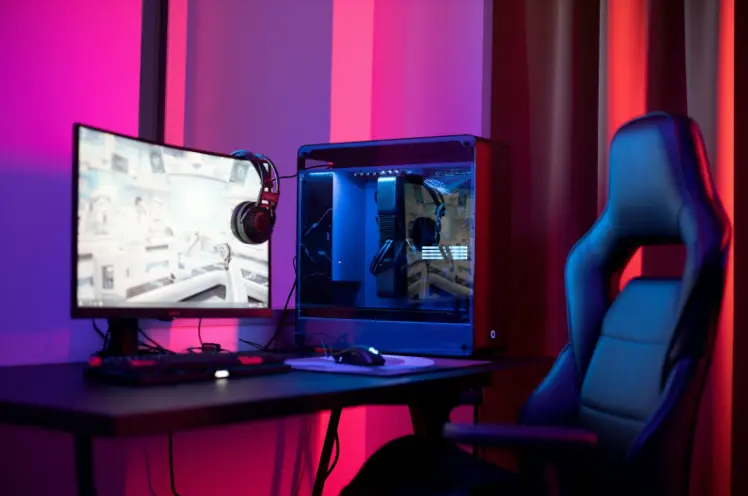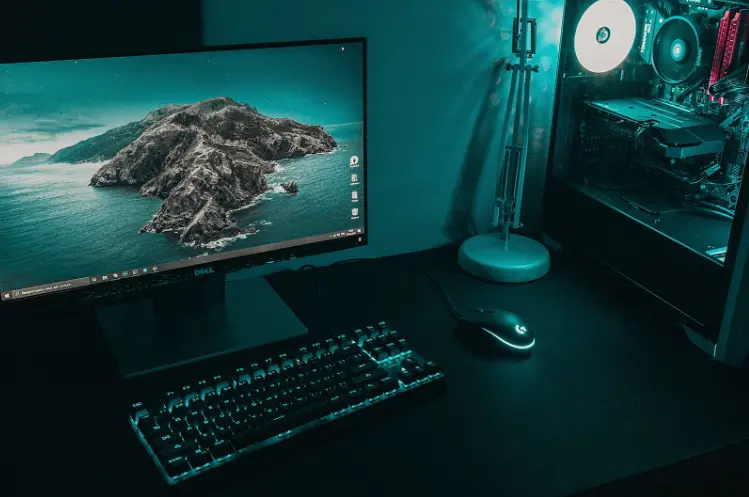Building a new computer from scratch is quite a complex and time-consuming task. Selecting the right configuration, finding a processor and graphics card within your budget, and connecting and assembling everything…
The temptation arises: “Maybe I should just buy a pre-built one?”. But this seemingly simple solution has many pitfalls. I’ll try to describe in detail how to avoid them in this article.
Let me clarify right away – this article is intended for beginners, for whom terms like “4 cores and 4 threads”, “dual-channel mode”, and “AMD faster than Intel” sound like gibberish.
Advanced PC users may skip right to the comments and add their own advice to the article.
Why is Buying a Complete PC Not Cost-Effective?
There are three main reasons.
First, it’s much more expensive. Naturally, sellers of pre-built PCs aren’t in the business of making losses. The price includes the computer components, the assembler’s labor, and (if we’re talking about a retail store) storage and transportation. And an unscrupulous seller might just inflate the prices by 10,000, simply by adding “Powerful Gaming Computer” to the name.
Second, the incompetence of assemblers. Whether in stores or private workshops, the people assembling PCs for you might… not understand too much about it. Most likely, your new computer will work, but in a year, it might start overheating because of bad thermal paste. And in two years, the power supply unit might fail because it’s cheap and highly unreliable.
A specific example – when assembling a PC, you should almost always buy RAM in two sticks to enable faster dual-channel mode. What do assemblers do? In 90% of cases, they install memory… in one stick. Because it’s cheaper. And your 8 GB will work significantly slower than 2 sticks of 4 GB each.
Finally, the third and most important reason – the assembler is not interested in the quality of your PC. Their goal: to spend as little as possible on the product while making more profit from you. Therefore, they will buy the cheapest motherboard (which will prevent you from upgrading your PC in a few years), install a weak processor without a graphics card, one stick of memory, and a Chinese power supply unit (which, in the event of a short circuit, will burn your entire computer).
To give this all a marketable appearance, assemblers buy cases with RGB lighting and install fancy fans. And this “product” will be sold at twice the price.
What to Do if You Must Buy a Pre-Built PC in 2023?

First and foremost – try to find a “consultant” among your friends. Ideally, this person has already built a computer for themselves/friends and knows what to recommend. If you have complaints about the seller, they can articulate them competently to demand a refund.
If you can’t find such a person – seek advice on thematic forums and websites. The responses might be somewhat blunt, but you’ll save time and money.
There are mainly four ways to get a pre-built PC, each with its own pros and cons:
Buying a Computer in a Store:
This is the simplest and most mundane method – but far from the best. The price for even the basic models is significantly inflated and does not correspond to reality. This is especially true for offline sales – where there are markups for transportation and storage. In smaller online stores, the price is better – but reliability becomes an issue. Ideally, choose a site that someone you know has used and was satisfied with. It’s not a 100% guarantee, but it’s better than paid reviews on the internet. High-quality gaming equipment selections, encompassing a wide range of products tailored to gaming needs, can be viewed on the Supergamereviews.com. This platform offers a comprehensive array of choices, making it a valuable resource for gamers looking for top-notch gear.
Ordering a PC from Private Assemblers:
This is a bit more complicated: you need to find an individual master or a small firm that assembles PCs. You contact them, discuss the computer’s budget and the assembler’s fee, and get the finished computer in a week.
The price will likely be lower than in stores, but there’s another problem. If buying a pre-built PC gives you a warranty (usually for a year), a private workshop won’t. The warranty on their receipts will likely not have legal force. Therefore, ask for all receipts for the purchased components – it will be more useful.
Ideally, look for a workshop, like a store, based on the reviews of trusted acquaintances. If you managed to find a “consultant” among friends – make sure they check the computer’s “innards” before the final payment: whether it matches what was agreed upon, and whether the assembly was done correctly.
By the way, in both cases, there’s the issue of the operating system. If you’re a regular user, free Linux won’t suit you, and a licensed Windows 10 adds + 100$ to the assembly budget.
I don’t recommend installing “pirated” versions, and it’s not very easy for someone who doesn’t understand PCs. Decide for yourself how to proceed.
Turning to a Computer-Savvy Friend:
Probably the most optimal option, as it solves the main problem: trust in the result. Here, you won’t be cheated, overcharged, or given a haphazard assembly. Unfortunately, not everyone has such acquaintances – but if you need a PC, it’s high time to find one.
You don’t have to burden one person with everything. I’ve helped acquaintances choose PC configurations for specific budgets, while someone else assembled it. In this case, you can even turn to barely known people: there’s less risk of being cheated.
Another option is when you (or someone else) monitor price fluctuations – and components are purchased exclusively at discounts/most advantageous prices. This can help save money – but to get the optimal option, you might have to wait a long time…
Buying a Laptop:
Probably the simplest and most qualitative option if you don’t want to bother. A decent office laptop starts from 1000$ , a gaming one – from 1500$. This is even cheaper than many desktop options. And as always, there are several “buts”:
Temperatures – in “heavy” games, the laptop may “hang” over time due to CPU overheating. And replacing thermal paste or individual components in a laptop is a separate and rather expensive story.
The impossibility of an upgrade – the main disadvantage of laptops. If you take the average price category of gaming laptops, you’ll be able to play on medium settings for a couple of years, then on minimum settings for another year. After that – it’s time to buy a new one.
On the other hand, if you only need an office PC – a laptop is perfect. The costs will be less or equal to buying a desktop PC, while you get mobility and a certain quality guarantee.
Specific Components – What to Look for When Buying a PC?

Suppose you have no acquaintances who are knowledgeable about PCs and don’t want to risk going to a private assembler. If purchasing from a standard online store becomes the chosen route, careful consideration of certain aspects is necessary. The components, when considered, should be prioritized based on their level of importance: the higher their placement, the more critical they are.
It’s pertinent to mention that the motherboard will not be a focus here, as its specifics hold greater relevance in the context of building a computer from the ground up. In the scenario of acquiring a pre-assembled PC, the particular model of the motherboard is not a critical factor.
Concerning the Processor, it acts as the upper limit of your computer’s capabilities.In cases where an advanced graphics card is coupled with a dated processor, underperformance may ensue, as illustrated by challenges in running high-demand games like Cyberpunk 2077, even at their lowest settings. It should be noted that the performance is influenced not solely by the core count but also by the thread count, where higher quantities generally lead to enhanced performance.
Specific models depend on your budgets, but the best option for a good assembly is Intel Core i5 10400 F or AMD Ryzen 5 3600. 6 cores and 12 threads are optimal for modern games. But if you work with rendering and graphics, you need to take top models.
The Graphics Card, considered a critical component particularly for gaming or 3D modeling computers, often represents the highest cost in a computer assembly. The quality of game graphics and the efficiency of video rendering are largely dependent on this component. For computers utilized in office settings, the necessity for a discrete graphics card is typically absent, as the integrated graphics within the processor are generally adequate.
It’s hard to recommend specific models, as prices change very quickly. The main thing is that the model should have at least 4GB of video memory. Otherwise, even on medium settings, there will be problems with modern games. The optimal choice is GeForce RTX 3060, but if the budget doesn’t allow – look for PCs with GeForce RTX 2060 or 1650, which will give you medium settings in all projects for a couple of years.
RAM:
Here, as mentioned, not only the volume is important, but also the dual-channel mode. Unfortunately, you can only check the number of RAM sticks in an offline store. There’s usually no such information on websites. But if you get a PC with one 8GB stick – don’t hesitate to spend a few hundred and buy a second one. It will significantly speed up your PC.
Power Supply Unit:
First, check its manufacturer and separate cost. A good power supply unit costs at least 100$. Very often, the power supply unit is where savings are made in pre-built PCs, which can lead to the loss of the entire computer (if, for example, a short circuit occurs).
Storage (HDD or SSD):
SSDs are more expensive – but the operation of games and the system will be much faster. HDDs hold more and are somewhat more reliable. If you have the opportunity – choose a PC with a good SSD (for the operating system and a few games), and then buy a separate HDD (for photos, videos, and other large files).
Case:
Look at it last. Any lighting, decorations, and design don’t affect the speed of operation. The main thing is that the case is well-ventilated and has several fans.
What’s the Outcome?
We tried to talk about the main problems with buying a PC and their solutions. From my side, I can only advise one thing – if you don’t have an acquaintance who can help with choosing or assembling a computer, it’s better to do it yourself.
Yes, it will take time and effort – but the skills you acquire will be useful. You will be able to not only assemble a PC but also maintain it (replace thermal paste, upgrade, add RAM) without resorting to strangers.
Whatever choice you make, I hope you can find the computer of your dreams. If you have any questions or comments, please write them in the comments.
